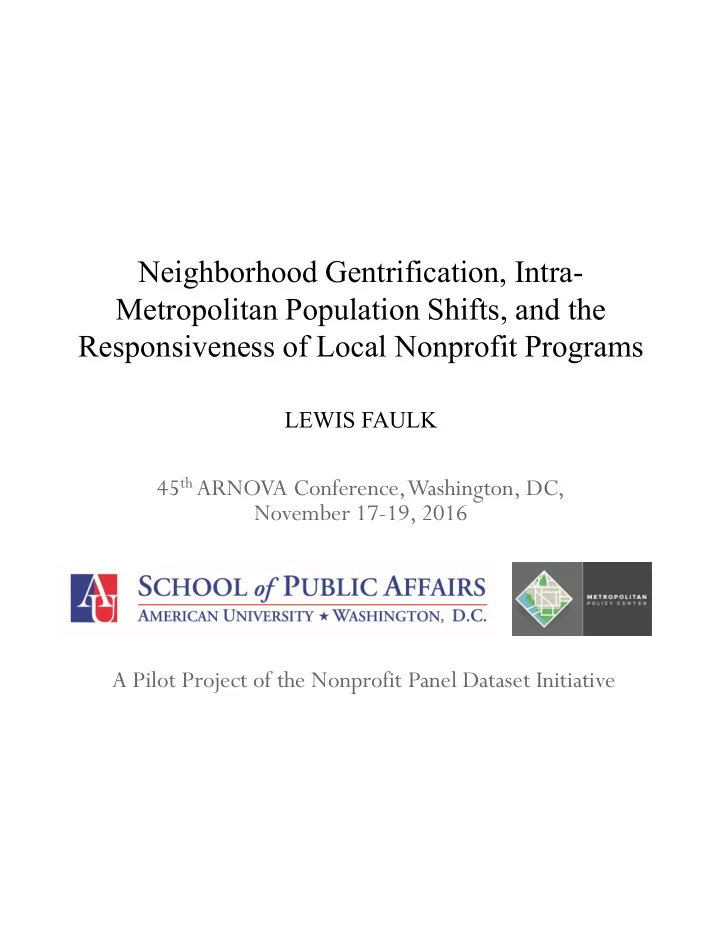

Neighborhood Gentrification, Intra- Metropolitan Population Shifts, and the Responsiveness of Local Nonprofit Programs LEWIS FAULK 45 th ARNOVA Conference, Washington, DC, November 17-19, 2016 A Pilot Project of the Nonprofit Panel Dataset Initiative
MOTIVATIONS 1) To understand local nonprofit program responses to gentrification in urban settings 2) To advance the Nonprofit Panel Dataset RESEARCH QUESTIONS 1) Do local nonprofits respond to changing needs by increasing low-income/minority programs or by increasing non- low-income/non-minority programs? 2) Do new organizations enter these markets or do existing organizations expand to meet new needs?
THEORETICAL PERSPECTIVES Dueling arguments from same theory? Public Goods/Demand Heterogeneity (Weisbrod 1975) � Nonprofits rise to meet public and collective needs that are not demanded by the median voter � As neighborhoods gentrify… � H1: Nonprofits will increase the local response to low-income, minority demands � H2: Nonprofits will increase the local response to non-low-income, non-minority demands
Nonprofit Panel Dataset Program Geographic Focus
Wave 1 Study Focus 18 Gentrification 2 21 22 and NP Response 7 25 27
Questions confronted… � Focus on Human Services or all subsectors ? � Non-Human-Service organizations also active in low- income, minority focused programs � How do we assess program changes from before gentrification? � Difficult with a survey alone � Program information through website vs. 990
Questions confronted… � Focus on Human Services or all subsectors ? � Non-Human-Service organizations also active in low- income, minority focused programs � How do we assess program changes from before gentrification? � Difficult with a survey alone � Program information through website vs. 990 � Initial Wave Solutions – Draw full population from neighborhoods and focus on 990 information beyond the NCCS Core
Nonprofit Panel Dataset Platform Neighborhood Organizations
DC Wave 1 Sample Frame Population of 990 Filing NPOs in DC Gentrifying Neighborhoods Neighborhood Cluster N Percent Cum. Cluster 2: Columbia Heights, Mt. Ple.. 119 23.38 23.38 Cluster 7: Shaw, Logan Circle 51 10.02 33.4 Cluster 18: Brightwood Park, Crestwoo.. 65 12.77 46.17 Cluster 21: Edgewood, Bloomingdale, T.. 74 14.54 60.71 Cluster 22: Brookland, Brentwood, La.. 62 12.18 72.89 Cluster 25: NoMa, Union Station, Stan.. 122 23.97 96.86 Cluster 27: Near Southeast, Navy Yard 16 3.14 100 Total 509 100
Sample Neighborhood NPOs Neighborhood Cluster N Percent Cum. Cluster 2: Columbia Heights, Mt. Ple.. 119 23.38 23.38 Cluster 7: Shaw, Logan Circle 51 10.02 33.4 Cluster 18: Brightwood Park, Crestwoo.. 65 12.77 46.17 Cluster 21: Edgewood, Bloomingdale, T.. 74 14.54 60.71 Cluster 22: Brookland, Brentwood, La.. 62 12.18 72.89 Cluster 25: NoMa, Union Station, Stan.. 122 23.97 96.86 Cluster 27: Near Southeast, Navy Yard 16 3.14 100 Total 509 100 Subsector N Percent Cum. Arts 54 10.61 10.61 Education 84 16.5 27.11 Health 50 9.82 36.94 Human Services 171 33.6 70.53 Other 150 29.47 100 Total 509 100
DATA & ANALYSIS � Program Service Accomplishments reported on the Form 990 from 2006 and 2015 � Program Descriptions, Expenses, and Revenue � Each program coded for 1) Local vs. Non-Local Program 2) Low-income/Minority-Serving/Community � Analysis of growth in Local Low-Income vs. Non- Low-Income Programs (N and Exps) � New vs. Existing Orgs and Programs
FINDINGS Local / Non-Local Neighborhood Cluster Gentrified? N Programs Local Program Spending 2006 2015 2006 2015 Cluster 2: Columbia Heights 2014 145/206 150/218 $80,800,000 $156,000,000 Cluster 7: Shaw 2009 53/84 71/101 $153,000,000 $59,200,000 Cluster 18: Brightwood/Petworth Trend by 2017 89/107 89/104 $35,700,000 $64,800,000 Cluster 21: Edgewood Trend by 2016 73/118 86/131 $408,000,000 902,000,000 Cluster 22: Brookland Trend by 2020 83/111 77/97 $48,700,000 $89,500,000 Cluster 25: Union Station 2014 32/249 45/240 $37,200,000 $220,000,000 Cluster 27: Navy Yard 2009 14/31 14/29 $41,200,000 $84,100,000
FINDINGS Neighborhood Cluster Gentrified? Local Low-Income Spending 2006 2015 Cluster 2: Columbia Heights 2014 $70,100,000 $127,000,000 Cluster 7: Shaw 2009 $148,000,000 $53,000,000 Cluster 18: Brightwood/Petworth Trend by 2017 $33,300,000 $63,200,000 Cluster 21: Edgewood Trend by 2016 $402,000,000 901,000,000 Cluster 22: Brookland Trend by 2020 $45,000,000 $85,500,000 Cluster 25: Union Station 2014 $13,700,000 $171,000,000 Cluster 27: Navy Yard 2009 $41,000,000 $81,500,000
Next Steps - Nonprofit Panel Dataset Core Questions Over Panel
For more information: faulk@american.edu www.american.edu/spa/faculty/faulk.cfm
Recommend
More recommend